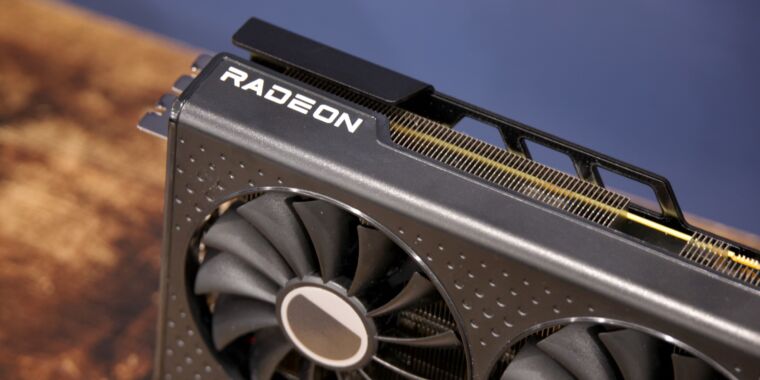-
XFX’s take on AMD’s Radeon RX 7600 XT.
Andrew Cunningham -
AMD mandates DisplayPort 2.1 support on the 7600 XT, where it’s optional on the regular 7600.
Andrew Cunningham -
XFX’s 7600 XT card dwarfs AMD’s reference RX 7600 card, mainly in size but also sort of in power use.
Andrew Cunningham
We don’t need a long intro for this one: AMD’s new Radeon RX 7600 XT is almost exactly the same as last year’s RX 7600, but with a mild bump to the GPU’s clock speed and 16GB of memory instead of 8GB. It also costs $329 instead of $269, the current MSRP (and current street price) for the regular RX 7600.
It’s a card with a pretty narrow target audience: people who are worried about buying a GPU with 8GB of memory, but who aren’t worried enough about future-proofing or RAM requirements to buy a more powerful GPU. It’s priced reasonably well, at least—$60 is a lot to pay for extra memory, but $329 was the MSRP for the Radeon RX 6600 back in 2021. If you want more memory in a current-generation card, you otherwise generally need to jump up into the $450 range (for the 12GB RX 7700 XT or the 16GB RTX 4060 Ti) or beyond.
| RX 7700 XT | RX 7600 | RX 7600 XT | RX 6600 | RX 6600 XT | RX 6650 XT | RX 6750 XT | |
|---|---|---|---|---|---|---|---|
| Compute units (Stream processors) | 54 (3,456) | 32 (2,048) | 32 (2,048) | 28 (1,792) | 32 (2,048) | 32 (2,048) | 40 (2,560) |
| Boost Clock | 2,544 MHz | 2,600 MHz | 2,760 MHz | 2,490 MHz | 2,589 MHz | 2,635 MHz | 2,600 MHz |
| Memory Bus Width | 192-bit | 128-bit | 128-bit | 128-bit | 128-bit | 128-bit | 192-bit |
| Memory Clock | 2,250 MHz | 2,250 MHz | 2,250 MHz | 1,750 MHz | 2,000 MHz | 2,190 MHz | 2,250 MHz |
| Memory size | 12GB GDDR6 | 8GB GDDR6 | 16GB GDDR6 | 8GB GDDR6 | 8GB GDDR6 | 8GB GDDR6 | 12GB GDDR6 |
| Total board power (TBP) | 245 W | 165 W | 190 W | 132 W | 160 W | 180 W | 250 W |
The fact of the matter is that this is the same silicon we’ve already seen. The clock speed bumps do provide a small across-the-board performance uplift, and the impact of the extra RAM does become apparent in a few of our tests. But the card doesn’t fundamentally alter the AMD-vs-Nvidia-vs-Intel dynamic in the $300-ish graphics card market, though it addresses a couple of the regular RX 7600’s most glaring weaknesses.
Performance and power
AMD’s official spec sheet for the 7600 XT advertises a 9.8 percent GPU game clock increase compared to the regular 7600, and a 3.8 percent boost clock increase. In most cases, with the XFX card we tested, performance improvements in most games were firmly in that low-single-digit range at both 1080p and 1440p.
One broad exception to this, and one specific exception, based on the tests we’ve run: Generally, games with heavy ray-tracing effects—Cyberpunk and Returnal, namely—improved more than the non ray-traced games we tested; at 1080p, we saw high-single-digit improvements, and at 1440p we actually measured double-digit speed increases. This is, unfortunately, not enough to make the RX 7600 XT’s ray-tracing performance particularly great, or competitive with the RTX 4060 running at the same resolutions and settings.
But there’s only one that shows a crystal-clear sign of video memory-related problems: Forza Horizon 5, which at 1440p begins throwing low-memory warnings on 8GB Radeon cards (it doesn’t seem to have the same issues with 8GB Nvidia cards, at least not as visibly; chalk it up to games being better-optimized for the GPU market leader, maybe). This manifests as scores that look lower than they “should,” and a lack of improvement (or even some backsliding) when you try to use FSR or XeSS upscaling.
The 16GB 7600 XT is a whopping 28 percent faster than the 7600 here, and nearly 62 percent faster once you turn FSR on. That’s a huge improvement for the money! Though it’s also not nearly representative of the behavior you’ll see from most games.

